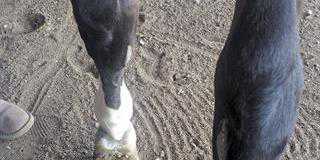
Photo: Dr Mac
Hens and chicks are often kept in stable yards to control insects. The birds scratch through the bedding and manure to find fly larvae, ticks and other undesirable bugs.
They also turn over the manure in compost heaps.
READ Tips for better chicken house heating and ventilation
Chickens are easy to keep as there is normally enough organic fowl feed in a stable – bugs and horse-feed – to provide a full ration for them.
The only cost is a small amount of oyster shell to boost the birds’ calcium and phosphate intake.
Another advantage of fowls is that they clean up after horses that are messy feeders. The horses are then less likely to get sand colic from swallowing a mouthful of sand along with feed that has fallen onto the floor.
Chickens offer an additional unexpected benefit: the horses get used to fluttering birds and are less likely to become spooked by fowls when they are being ridden.
Depending on the breed of chicken, you can get an additional income from the sale of chicks. Eggs are another fringe benefit, of course.
Disadvantages of chickens
Unfortunately, there are several downsides to keeping chickens in a stable yard:
- If they roost in the rafters, you may find the large splashes of white manure on your horses irritating. These are harmless, however, and can easily be groomed off;
- It can be inconvenient if hens choose to lay eggs in your hay bales. You may not find the eggs until they fall out and break into a smelly mess when you’re filling teff nets. Both of these problems can be largely avoided if you build a chicken coop and keep hens, chicks and roosters inside it at night.
- Salmonella is present in the faeces of some chickens and can pollute water sources. However, the risk is not very high in free-range stable-yard poultry. The birds consume manure and so are likely to have the same gastrointestinal bacteria as your horses.
Chicken breeds
Bantams: These tend to be the most popular stable yard chickens in South Africa. They are cute and easily saleable as pets. This can be important, as horse owners are generally not keen on slaughtering their chickens or even selling them for meat. Many do not even collect the eggs, preferring the sight of a mother hen teaching her chicks to scrabble through the manure.
Visit the poultryclubsa.co.za to find out more about the value and history of the various bantam breeds.
Silkies
These fluffy white chickens are also often seen in stable yards. They make excellent pets and live a long time. Some are bantam-sized, but they are not true bantams. Female Silkies have good maternal instincts and are sometimes used to incubate the eggs of other chicken breeds. Their meat and even the bones are black, so they are not usually stolen to fill someone’s pot.
Potchefstroom Koek-koek
This popular breed also has good maternal instincts. A hen will fluff out her feathers if she feels that her chicks are threatened. Horses generally move out of the way when a hen brings her chicks into a paddock or stable. These free-range fowls grow slowly and are generally marketed at maturity for between R100 and R200 each through friends, at local auctions or on the Internet.
Whichever breed you choose, remember that, when buying hens and roosters, the best source is another stable yard, where the chickens are accustomed to horses.













